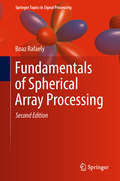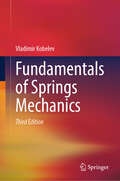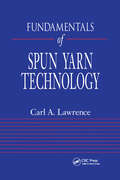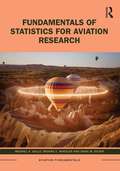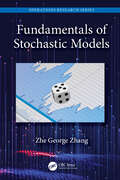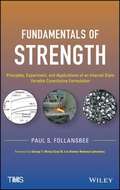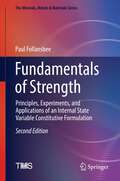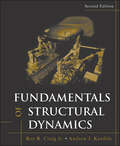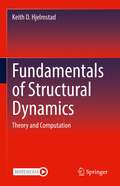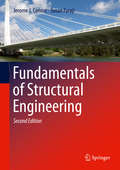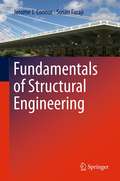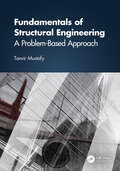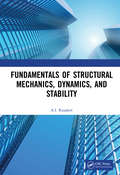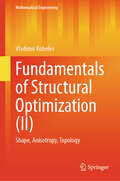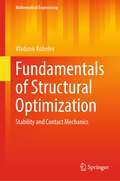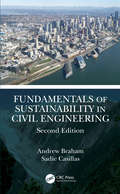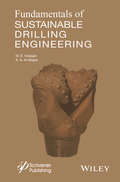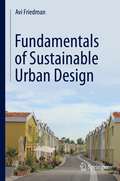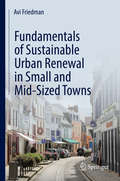- Table View
- List View
Fundamentals of Spherical Array Processing (Springer Topics In Signal Processing Ser. #8)
by Boaz RafaelyThis book provides a comprehensive introduction to the theory and practice of spherical microphone arrays, and was written for graduate students, researchers and engineers who work with spherical microphone arrays in a wide range of applications. The new edition includes additions and modifications, and references supplementary Matlab code to provide the reader with a straightforward start for own implementations. The book is also accompanied by a Matlab manual, which explains how to implement the examples and simulations presented in the book.The first two chapters provide the reader with the necessary mathematical and physical background, including an introduction to the spherical Fourier transform and the formulation of plane-wave sound fields in the spherical harmonic domain. In turn, the third chapter covers the theory of spatial sampling, employed when selecting the positions of microphones to sample sound pressure functions in space. Subsequent chapters highlight various spherical array configurations, including the popular rigid-sphere-based configuration. Beamforming (spatial filtering) in the spherical harmonics domain, including axis-symmetric beamforming, and the performance measures of directivity index and white noise gain are introduced, and a range of optimal beamformers for spherical arrays, including those that achieve maximum directivity and maximum robustness are developed, along with the Dolph–Chebyshev beamformer. The final chapter discusses more advanced beamformers, such as MVDR (minimum variance distortionless response) and LCMV (linearly constrained minimum variance) types, which are tailored to the measured sound field.
Fundamentals of Springs Mechanics
by Vladimir KobelevThis book highlights the mechanics of the elastic elements made of steel alloys with a focus on the metal springs for automotive industry. The industry and scientific organizations study intensively the foundations of design of spring elements and permanently improve the mechanical properties of spring materials. The development responsibilities of spring manufacturing company involve the optimal application of the existing material types. Thus, the task entails the target-oriented evaluation of the mechanical properties and the subsequent design of the springs, which makes full use of the attainable material characteristics. The themes about the new design of disk springs and the hereditary mechanics—namely creep and relaxation resistance—were extended. The fatigue life diagrams were reconsidered, and the relations between the traditional diagrams revealed. The book stands as a valuable reference for professionals in practice as well as an advanced learning resource for students of structural and automotive engineering. The former editions were known as "Durability of Springs”. Reflecting the substantial enlargement of the discussed themes, starting with this 3rd Edition the book entitled as "Fundamentals of Springs Mechanics”.
Fundamentals of Spun Yarn Technology
by Carl A. LawrenceExisting textbooks covering the subject of yarn manufacture largely concentrate on describing the workings of machines. Fundamentals of Spun Yarn Technology presents complete coverage of yarn manufacture and technology and current research findings on the structure and properties of spun yarns. Written by a well-known and respected authority on tex
Fundamentals of Statistics for Aviation Research (Aviation Fundamentals)
by Michael A. Gallo Brooke E. Wheeler Isaac M. SilverThis is the first textbook designed to teach statistics to students in aviation courses. All examples and exercises are grounded in an aviation context, including flight instruction, air traffic control, airport management, and human factors. Structured in six parts, this book covers the key foundational topics relative to descriptive and inferential statistics, including hypothesis testing, confidence intervals, z and t tests, correlation, regression, ANOVA, and chi-square. In addition, this book promotes both procedural knowledge and conceptual understanding. Detailed, guided examples are presented from the perspective of conducting a research study. Each analysis technique is clearly explained, enabling readers to understand, carry out, and report results correctly. Students are further supported by a range of pedagogical features in each chapter, including objectives, a summary, and a vocabulary check. Digital supplements comprise downloadable data sets and short video lectures explaining key concepts. Instructors also have access to PPT slides and an instructor’s manual that consists of a test bank with multiple choice exams, exercises with data sets, and solutions. This is the ideal statistics textbook for aviation courses globally, especially in aviation statistics, research methods in aviation, human factors, and related areas.
Fundamentals of Stochastic Models (Operations Research Series)
by Zhe George ZhangStochastic modeling is a set of quantitative techniques for analyzing practical systems with random factors. This area is highly technical and mainly developed by mathematicians. Most existing books are for those with extensive mathematical training; this book minimizes that need and makes the topics easily understandable. Fundamentals of Stochastic Models offers many practical examples and applications and bridges the gap between elementary stochastics process theory and advanced process theory. It addresses both performance evaluation and optimization of stochastic systems and covers different modern analysis techniques such as matrix analytical methods and diffusion and fluid limit methods. It goes on to explore the linkage between stochastic models, machine learning, and artificial intelligence, and discusses how to make use of intuitive approaches instead of traditional theoretical approaches. The goal is to minimize the mathematical background of readers that is required to understand the topics covered in this book. Thus, the book is appropriate for professionals and students in industrial engineering, business and economics, computer science, and applied mathematics.
Fundamentals of Strength: Principles, Experiment, and Applications of an Internal State Variable Constitutive Formulation
by George T. Gray III Paul S. FollansbeeOffers data, examples, and applications supporting the use of the mechanical threshold stress (MTS) model Written by Paul S. Follansbee, an international authority in the field, this book explores the underlying theory, mechanistic basis, and implementation of the mechanical threshold stress (MTS) model. Readers are introduced to such key topics as mechanical testing, crystal structure, thermodynamics, dislocation motion, dislocation-obstacle interactions, hardening through dislocation accumulation, and deformation kinetics. The models described in this book support the emerging theme of Integrated Computational Materials Engineering (ICME) by offering a foundation for the bridge between length scales characterizing the mesoscale (mechanistic) and the macroscopic. Fundamentals of Strength begins with a chapter that introduces various approaches to measuring the strength of metals. Next, it covers: Structure and bonding Contributions to strength Dislocation-obstacle interactions Constitutive law for metal deformation Further MTS model developments Data analysis: deriving MTS model parameters The next group of chapters examines the application of the MTS model to copper and nickel, BCC metals and alloys, HCP metals and alloys, austenitic stainless steels, and heavily deformed metals. The final chapter offers suggestions for the continued development and application of the MTS model. To help readers fully understand the application of the MTS model, the author presents two fictional materials along with extensive data sets. In addition, end-of-chapter exercises give readers the opportunity to apply the models themselves using a variety of data sets. Appropriate for both students and materials researchers, Fundamentals of Strength goes beyond theory, offering readers a model that is fully supported with examples and applications.
Fundamentals of Strength: Principles, Experiments, and Applications of an Internal State Variable Constitutive Formulation (The Minerals, Metals & Materials Series)
by Paul FollansbeeThis second edition updates and expands on the class-tested first edition text, augmenting discussion of dynamic strain aging and austenitic stainless steels and adding a section on analysis of nickel-base superalloys that shows how the mechanical threshold stress (MTS) model, an internal state variable constitutive formulation, can be used to de-convolute synergistic effects. The new edition retains a clear and rigorous presentation of the theory, mechanistic basis, and application of the MTS model. Students are introduced to critical competencies such as crystal structure, dislocations, thermodynamics of slip, dislocation–obstacle interactions, deformation kinetics, and hardening through dislocation accumulation. The model described in this volume facilitates readers’ understanding of integrated computational materials engineering (ICME), presenting context for the transition between length scales characterizing the mesoscale (mechanistic) and the macroscopic. Presenting readers a model buttressed by detailed examples and applications, the textbook is ideal for students, practitioners, and materials researchers.
Fundamentals of Structural Dynamics
by Andrew J. Kurdila Roy R. CraigFrom theory and fundamentals to the latest advances in computational and experimental modal analysis, this is the definitive, updated reference on structural dynamics.This edition updates Professor Craig's classic introduction to structural dynamics, which has been an invaluable resource for practicing engineers and a textbook for undergraduate and graduate courses in vibrations and/or structural dynamics. Along with comprehensive coverage of structural dynamics fundamentals, finite-element-based computational methods, and dynamic testing methods, this Second Edition includes new and expanded coverage of computational methods, as well as introductions to more advanced topics, including experimental modal analysis and "active structures." With a systematic approach, it presents solution techniques that apply to various engineering disciplines. It discusses single degree-of-freedom (SDOF) systems, multiple degrees-of-freedom (MDOF) systems, and continuous systems in depth; and includes numeric evaluation of modes and frequency of MDOF systems; direct integration methods for dynamic response of SDOF systems and MDOF systems; and component mode synthesis.Numerous illustrative examples help engineers apply the techniques and methods to challenges they face in the real world. MATLAB(r) is extensively used throughout the book, and many of the .m-files are made available on the book's Web site. Fundamentals of Structural Dynamics, Second Edition is an indispensable reference and "refresher course" for engineering professionals; and a textbook for seniors or graduate students in mechanical engineering, civil engineering, engineering mechanics, or aerospace engineering.
Fundamentals of Structural Dynamics: Theory and Computation
by Keith D. HjelmstadThis text closes the gap between traditional textbooks on structural dynamics and how structural dynamics is practiced in a world driven by commercial software, where performance-based design is increasingly important. The book emphasizes numerical methods, nonlinear response of structures, and the analysis of continuous systems (e.g., wave propagation). Fundamentals of Structural Dynamics: Theory and Computation builds the theory of structural dynamics from simple single-degree-of-freedom systems through complex nonlinear beams and frames in a consistent theoretical context supported by an extensive set of MATLAB codes that not only illustrate and support the principles, but provide powerful tools for exploration. The book is designed for students learning structural dynamics for the first time but also serves as a reference for professionals throughout their careers.
Fundamentals of Structural Engineering
by Jerome J. Connor Susan FarajiFundamentals of Structural Engineering provides a balanced, seamless treatment of both classic, analytic methods and contemporary, computer-based techniques for conceptualizing and designing a structure. The book?s principle goal is to foster an intuitive understanding of structural behavior based on problem solving experience for students of civil engineering and architecture who have been exposed to the basic concepts of engineering mechanics and mechanics of materials. Distinct from many undergraduate textbooks, which are focused mainly on either teaching manual analysis methods and applying them to simple, idealized structures or reformulating structural analysis methods in terms of matrix notation, this text instead encourages the student to develop intuition about structural behavior. The authors of this text recognize the notion that engineers reason about behavior using simple models and intuition they acquire through problem solving. The approach adopted in this text develops this type of intuition by presenting extensive, realistic problems and case studies together with computer simulation, which allows rapid exploration of how a structure responds to changes in geometry and physical parameters.
Fundamentals of Structural Engineering
by Jerome J. Connor Susan FarajiFundamentals of Structural Engineering provides a balanced, seamless treatment of both classic, analytic methods and contemporary, computer-based techniques for conceptualizing and designing a structure. The book?s principle goal is to foster an intuitive understanding of structural behavior based on problem solving experience for students of civil engineering and architecture who have been exposed to the basic concepts of engineering mechanics and mechanics of materials. Distinct from many undergraduate textbooks, which are focused mainly on either teaching manual analysis methods and applying them to simple, idealized structures or reformulating structural analysis methods in terms of matrix notation, this text instead encourages the student to develop intuition about structural behavior. The authors of this text recognize the notion that engineers reason about behavior using simple models and intuition they acquire through problem solving. The approach adopted in this text develops this type of intuition by presenting extensive, realistic problems and case studies together with computer simulation, which allows rapid exploration of how a structure responds to changes in geometry and physical parameters.
Fundamentals of Structural Engineering: A Problem-Based Approach
by Tanvir MustafyThis book provides an introduction to the principles of structural engineering using a problem-based approach. It covers the basic concepts of structural analysis and design, including statics, strength of materials, and mechanics of materials. The text emphasizes the application of these principles to real-world structural engineering problems and includes numerous example problems and case studies to illustrate key concepts. The problem-based approach helps students develop their problem-solving skills, critical thinking abilities, and intuition for structural engineering. Fundamentals of Structural Engineering: A Problem-Based Approach is designed for undergraduate students studying structural engineering or related fields. Covers all the key concepts in structural engineering, including statics, strength of materials, mechanics of materials, load estimation, and analysis techniques. Utilizes a problem-based approach that helps students understand and apply the principles of structural engineering in a practical, hands-on way. Includes numerous worked examples, practice problems, and case studies that provide students with a clear understanding of how the concepts they have learned can be applied to real-world structural engineering problems.
Fundamentals of Structural Mechanics, Dynamics, and Stability
by A.I. RusakovFundamentals of Structural Mechanics, Dynamics, and Stability examines structural mechanics from a foundational point of view and allows students to use logical inference and creative reasoning to solve problems versus rote memorization. It presents underlying theory and emphasizes the relevant mathematical concepts as related to structural mechanics in each chapter. Problems, examples, and case studies are provided throughout, as well as simulations to help further illustrate the content. Features: Presents the material from general theory and fundamentals through to practical applications. Explains the finite element method for elastic bodies, trusses, frames, non-linear behavior of materials, and more. Includes numerous practical worked examples and case studies throughout each chapter. Fundamentals of Structural Mechanics, Dynamics, and Stability serves as a useful text for students and instructors as well as practicing engineers.
Fundamentals of Structural Optimization: Shape, Anisotropy, Topology (Mathematical Engineering)
by Vladimir KobelevThis book provides a comprehensive overview of analytical methods for solving optimization problems, covering principles and mathematical techniques alongside numerical solution routines, including MAPLE and MAXIMA optimization routines. Each method is explained with practical applications and ANSYS APDL scripts for select problems. Chapters delve into topics such as scaling methods, torsion compliance, shape variation, topological optimization, anisotropic material properties, and differential geometry. Specific optimization problems, including stress minimization and mass reduction under constraints, are addressed. The book also explores isoperimetric inequalities and optimal material selection principles. Appendices offer insights into tensors, differential geometry, integral equations, and computer algebra codes. Overall, it's a comprehensive guide for engineers and researchers in structural optimization.
Fundamentals of Structural Optimization: Stability and Contact Mechanics (Mathematical Engineering)
by Vladimir KobelevThis book serves as a complementary resource to the courses "Advanced structural optimization" and "Structural optimization in automotive engineering" taught by the author at the University of Siegen, North-Rhine-Westphalia, Germany since 2001. Focusing on optimization problems in the field of structural engineering, this book offers a rigorous and analytical approach to problem-solving. Each chapter of the book begins with a brief overview of classical results and the derivation of governing equations. The solutions to optimization problems are then presented in a closed form, with the author guiding readers through several analytical methods for solving stability and contact tasks. Throughout the book, the author takes care to ensure that even readers without extensive experience in numerical computations can understand the conclusion of each relation. The book features several basic optimization problems, selected from a large pool of previously solved problems, with a particular emphasis on the unique features of optimization problems. By presenting analytical solutions, readers can better understand other known optimization problems and gain the skills needed to independently set and solve new problems. With its comprehensive and rigorous approach to problem-solving, this book is sure to enhance the reader's understanding of the field and equip them with the skills needed to tackle new challenges.
Fundamentals of Sustainability in Civil Engineering
by Andrew BrahamThis book will provide a foundation to understand the development of sustainability in civil engineering, and tools to address the three pillars of sustainability: economics, environment, and society. It will also include case studies in the four major areas of civil engineering: environmental, structural, geotechnical, and transportation, and utilize the concepts found on the Fundamentals of Engineering (FE) exam. It is intended for upper-level civil engineering sustainability courses. In addition, practical report writing and presentation giving will be proposed as evaluation metrics versus standard numerical questions and exam-based evaluations found in most civil engineering courses.
Fundamentals of Sustainability in Civil Engineering
by Andrew Braham Sadie CasillasThis book provides a foundation to understand the development of sustainability in civil engineering, and tools to address the three pillars of sustainability: economics, environment, and society. It includes case studies in the five major areas of civil engineering: environmental, structural, geotechnical, transportation, and construction management. This second edition is updated throughout and adds new chapters on construction engineering as well as an overview of the most common certification programs that revolve around environmental sustainability. Features: Updated throughout and adds two entirely new chapters Presents a review of the most common certification programs in sustainability Offers a blend of numerical and writing-based problems, as well as numerous application-based examples that utilize concepts found on the Fundamentals of Engineering (FE) exam Includes several practical case studies Offers a solution manual for instructors Fundamentals of Sustainability in Civil Engineering is intended for upper-level civil engineering sustainability courses. A unique feature is that concepts found in the Fundamentals of Engineering (FE) exam were targeted to help senior-level students refresh and prepare.
Fundamentals of Sustainable Aviation (Aviation Fundamentals)
by Eva MalevitiFundamentals of Sustainable Aviation is the first textbook to survey the critical field of sustainability within the aviation industry. Taking a systems thinking approach, it presents the foundational principles of sustainability and methodically applies them to different aviation sectors. Opening with the basics of sustainability, emphasising the Sustainable Development Goals, the book then considers the environmental, economic and social dimensions of aviation. The following chapters apply these insights to aviation design, supply chains, operations, maintenance and facilities. The final chapter examines the concept of resilience in sustainable aviation. Overall, the textbook shows how future sustainability can be achieved by making better decisions today. Students are supported with international case studies throughout the book. Slides, test questions and a teaching manual are available for instructors. This textbook is the ideal resource for courses on sustainable aviation globally and will also be of great interest to professionals in the field.
Fundamentals of Sustainable Aviation (ISSN)
by Eva MalevitiFundamentals of Sustainable Aviation is the first textbook to survey the critical field of sustainability within the aviation industry. Taking a systems thinking approach, it presents the foundational principles of sustainability and methodically applies them to different aviation sectors.Opening with the basics of sustainability, emphasising the Sustainable Development Goals, the book then considers the environmental, economic and social dimensions of aviation. The following chapters apply these insights to aviation design, supply chains, operations, maintenance and facilities. The final chapter examines the concept of resilience in sustainable aviation. Overall, the textbook shows how future sustainability can be achieved by making better decisions today.Students are supported with international case studies throughout the book. Slides, test questions and a teaching manual are available for instructors. This textbook is the ideal resource for courses on sustainable aviation globally and will also be of great interest to professionals in the field.
Fundamentals of Sustainable Drilling Engineering
by Abdulaziz Abdullah Al-Majed M. E. HossainThe book clearly explains the concepts of the drilling engineering and presents the existing knowledge ranging from the history of drilling technology to well completion. This textbook takes on the difficult issue of sustainability in drilling engineering and tries to present the engineering terminologies in a clear manner so that the new hire, as well as the veteran driller, will be able to understand the drilling concepts with minimum effort. This textbook is an excellent resource for petroleum engineering students, drilling engineers, supervisors & managers, researchers and environmental engineers for planning every aspect of rig operations in the most sustainable, environmentally responsible manner, using the most up-to-date technological advancements in equipment and processes.
Fundamentals of Sustainable Urban Design
by Avi FriedmanThis book begins with an introduction describing current societal transformations that merit new urban designs, including depletion of non-renewable natural resources, elevated levels of greenhouse gas emissions, large numbers of aging “Baby Boomers,” and climate change. Dr. Friedman then examines these challenges through thirty chapters of interest to urban designers, architects, civil and construction engineers, and town planners. Each of these topics represents an aspect of urban design and describes an innovative solution and offers a detailed description of underlying principles. The highly illustrated text presents innovative urban design strategies based on sustainable principles. Integrated with each chapter are several international case studies illustrating design implementations.
Fundamentals of Sustainable Urban Renewal in Small and Mid-Sized Towns
by Avi FriedmanThe book introduces challenges affecting smaller urban communities with fewer than 50,000 inhabitants and offers urban planning and building/architectural strategies to strengthen their city centers. It divides urban renewal of small towns into sub-components such as environmental challenges, demographic trends, economic changes and cultural aspects, and aging infrastructure. In each, context is established, and principles are outlined and illustrated. Topics include urban form, mobility and connectivity, infill neighborhoods design, wealth generation, and promotion of local culture and well‐being. Reinforced with detailed case studies, Fundamentals of Sustainable Urban Renewal in Small and Mid‐Sized Towns is an ideal resource for municipal planners, architects, civil engineers, and policy makers.
Fundamentals of Systems Biology: From Synthetic Circuits to Whole-cell Models
by Markus W. Covert<p>For decades biology has focused on decoding cellular processes one gene at a time, but many of the most pressing biological questions, as well as diseases such as cancer and heart disease, are related to complex systems involving the interaction of hundreds, or even thousands, of gene products and other factors. How do we begin to understand this complexity? <p><i>Fundamentals of Systems Biology: From Synthetic Circuits to Whole-cell Models</i> introduces students to methods they can use to tackle complex systems head-on, carefully walking them through studies that comprise the foundation and frontier of systems biology. The first section of the book focuses on bringing students quickly up to speed with a variety of modeling methods in the context of a synthetic biological circuit. This innovative approach builds intuition about the strengths and weaknesses of each method and becomes critical in the book’s second half, where much more complicated network models are addressed—including transcriptional, signaling, metabolic, and even integrated multi-network models. <p>The approach makes the work much more accessible to novices (undergraduates, medical students, and biologists new to mathematical modeling) while still having much to offer experienced modelers--whether their interests are microbes, organs, whole organisms, diseases, synthetic biology, or just about any field that investigates living systems.</p>
Fundamentals of Systems Biology: From Synthetic Circuits to Whole-cell Models
by Markus W. CovertFor decades biology has focused on decoding cellular processes one gene at a time, but many of the most pressing biological questions, as well as diseases such as cancer and heart disease, are related to complex systems involving the interaction of hundreds, or even thousands, of gene products and other factors. How do we begin to understand this complexity? Fundamentals of Systems Biology: From Synthetic Circuits to Whole-cell Models introduces students to methods they can use to tackle complex systems head-on, carefully walking them through studies that comprise the foundation and frontier of systems biology. The first section of the book focuses on bringing students quickly up to speed with a variety of modeling methods in the context of a synthetic biological circuit. This innovative approach builds intuition about the strengths and weaknesses of each method and becomes critical in the book’s second half, where much more complicated network models are addressed—including transcriptional, signaling, metabolic, and even integrated multi-network models. The approach makes the work much more accessible to novices (undergraduates, medical students, and biologists new to mathematical modeling) while still having much to offer experienced modelers--whether their interests are microbes, organs, whole organisms, diseases, synthetic biology, or just about any field that investigates living systems.
Fundamentals of Tank and Process Equipment Design (Foundations of Engineering Mechanics)
by András NagyThis book offers a comprehensive guide to the design and construction of process equipment and storage tanks. It covers the theoretical fundamentals of calculation methods and dimensioning techniques used in the design process, as well as the interpretation and evaluation of finite element examination results for stress concentrating cross-sections. Additionally, the book showcases corrosion-proof design through real-world examples. All measurement and calculation results presented in the book are based on the author's original research work.
